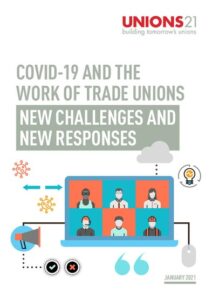Covid-19 and the Work of Unions: New Challenges and New Responses
Buoyed by membership growth and increased online engagement with members, this new report shows how unions have acted as both a vital challenger and partner during the COVID-19 pandemic in the effort to protect jobs, ensure industries remain viable and keep workers safe.
The study investigated how the work of unions changed when large parts of the economy were shut down, when going to work became a matter of life and death, and when work for millions of people, including most union staff, moved into their homes. It finds that:
– The pandemic has led unions to review all aspects of their work. Unions have transformed their working practices and embraced remote working.
– Unions have adapted to create new digital ways for workers to act and speak together, and developed new forms and methods of campaigning, negotiating, lobbying, training and representation, blending on and offline work.
– Unions have a renewed sense of purpose. A survey of union staff found that 70% think their union is stronger now than before the pandemic began.
The report is written by Tom Hunt, Deputy Director of the Sheffield Political Economy Research Institute (SPERI) at the University of Sheffield, and is produced with support from The Alex Ferry Foundation. The research is based on interviews and surveys of a wide range of union staff and reps.
Key Findings
– Unions have a reinvigorated sense of purpose. Staff teams have come together, member engagement has increased and deepened, activism has increased, and there are signs that membership will have increased during 2020
– Unions have secured wins for members like the furlough scheme and greater provision of PPE, influenced the national debate about conditions of key workers and put the spotlight on low-paid, unsafe and under-valued work
– In the post-COVID world it won’t be possible for unions to return to pre-pandemic ‘business as usual’ ways of working. Reflecting and evaluating what has worked during the pandemic so far and crucially why will help unions continue to adapt and build on changes made in 2020.
Click the image below to read the full report




